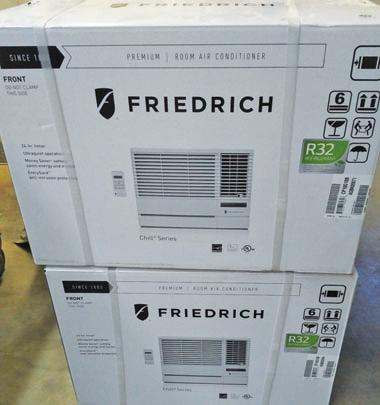
11 minute read
Refrigeration
Restrictions placed on HFC imports will likely increase the usage of flammable refrigerants, like the use of R-32 in this air conditioner.
“Inconceivable” R-22 ban now in effect, flammable refrigerants gaining ground By Greg Scrivener
In what has become an almost annual event; it is time to talk again about the changes we are seeing in refrigerants.
This year, the R-22 production and import ban took effect Jan. 1, marking a milestone of the original CFC/HCFC phaseout that started with the Montreal Protocol in 1987. This is a significant milestone because R-22 was ubiquitous. It was in every single commercial and residential air conditioner I worked on as an apprentice; even though we were knee deep in figuring out POE oil, refrigerant blends with glide, and dealing with the R-12 and R-502 transition.
To an apprentice refrigeration mechanic in the mid/late 1990s, it was almost inconceivable that R-22 would actually be

Table 1: HFC phase-down steps under the Kigali amendment r eduction from baseline (percentage).
phased out. Pe rhaps this is why for me the January 2020 phase-out evoked a somewhat sentimental and nostalgic response because it means I’m getting old. The adage that history repeats itself is certainly ringing true as we begin the phase-down of most of the refrigerants that we used to replace R-22 (and all the other CFC and HCFCs) over the last 20 years.
Environmental commitment
One year before the January 2020 R-22 production and import ban, Canada had already embarked on the mission to reduce greenhouse gas emissions caused by HFC refrigerants in order tomeet our commitment to the Kigali amendment to the Montreal Protocol.
We have covered the Montreal Protocol and the Kigali amendment here before on several occasions, so I don’t want to rehash too much detail. As a refresher, the Kigali amendment came into force in January 2 019 and the goal was to reduce the HFC consumption levels by 85 per cent by 2047. Canada has adopted an approach that combines a reduction in the allowable HFC importation and production, co mbined with regulations that force certain
Products Containing or Designed to Contain an HFC Used as a Refrigerant
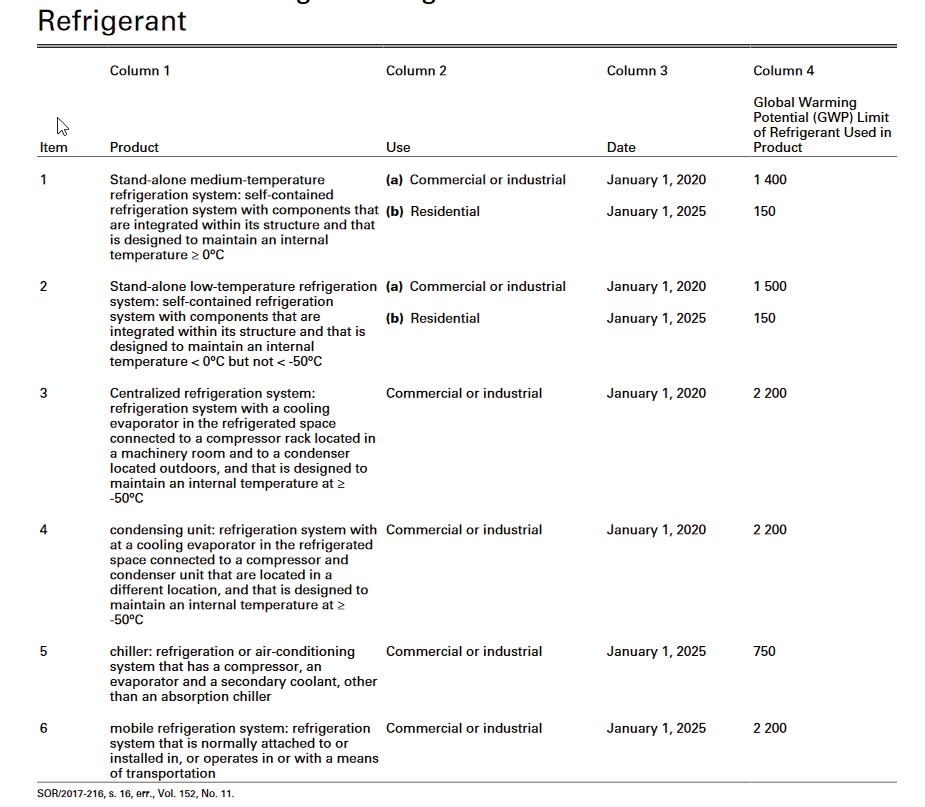
technologies/applications to use refrigerants with global warming potentials (GWPs) underneath a certain threshold.
In other words, even though the refrigerant itself may not be banned, it may be against the regulation to use it in certain applications. Table 1 shows Canada’s commitment to reduce HFC consumption from the baseline and Table 2 shows the application of specific restrictions.
know are not going to be the best choice
next year.
One point of particular interest is the fact that domestic air conditioning is not on the product specific list. This omission is because when the regulations were written there was no clear alternative. As we have discussed before, the current front runners
Table 2: Application restrictions for HFC refrigerants in Canada published in the Ozone-depleting Substances and Halocarbon Alternatives Regulations.
for reduction of the GWP for domestic air conditioning are refrigerants that have an A2L safety classification, meaning they are flammable.
Table 3 shows the GWP of several refrigerants that are in use today and some alternatives. The refrigerants in the second column were those used in the analysis completed during the “Regulatory Impact Analysis” of this amendment to the “Ozonedepleting Substances and Halocarbon Alternatives Regulations” in 2016.
Even though we are ignoring foam blowing agents and vehicle air conditioning, it is not hard to spot the challenge. When you compare the GWP reduction we are achieving with the application specific regulations compared to our commitment of a reduction to the baseline, it’s going to be hard to make it.
The regulators know this and provided some ideas of possible future refrigerant solutions in the “Regulator Impact Assessment.” If you are into this kind of thing, the assessment and public comments are quite interesting and make for good bedtime reading.
Flammable refrigerants
This difficulty and the fact that HFC imports are going to be restricted likely means an increased use in flammable refrigerants; most of you have likely seen R-32 window air conditioners and the increase in R-290 (propane) reach-in coolers. Ultimately, several refrigerants that look “safe” now, like R-410A, are probably not going to stick around as long as we think.
Last month, the EPA in the United States published a SNAP (Significant New Alternatives Policy) approval for R-448A and R-449A for use in stand alone refrigeration
Please see ‘Resurgence’ on page 39

Table 3: Refrigerant GWP comparison.
Resurgence of hydrocarbons, CO2 and ammonia
Continued from page 37
but made it subject to narrowed use. This means that it can only be used in very specific cases if the manufacturer properly documents the reasons and efforts they made to choose an alternative. In other words, there are lower GWP alternatives. Contrast this with the impression that I get in the industry when I speak with service technicians who are just adopting R-448A/R-449A.
In Canada, we have a federal policy and regulation guiding this process. In the U.S., individual states are picking up the slack caused by a host of recent deregulation and more ambitious climate targets. California, for example, is on pace to achieve Kigali level reductions in less than 10 years. Since our economies are closely tied and equipment availability is interconnected, the U.S. regulations can influence Canada significantly.
If one thing is clear, it’s that the new transition is just the beginning and we have many years of uncertainty to look forward to. Hardly a week goes by where I am not asked what to do with R-22 equipment and I’ve also had several companies start discussions on how to transition air conditioning equipment away from R-410A. Before you discount this, there are already several “drop-ins” for R-410A in development and on the market. R-470A, for example, is not flammable and has a GWP of 909, less than half of R-410A. The uncertainty makes deciding what refrigerant to use quite hard.
Endless amount of choices
In direct expansion air conditioning, there are no easy options at the moment since the A2L refrigerants are not readily available and our safety codes haven’t kept pace to allow their use, but in custom built refrigeration equipment the choice sometimes feels endless. The low GWP refrigerants are not always easy to get, our safety standards have not been updated to allow the use of A2L refrigerants and there is not a lot of
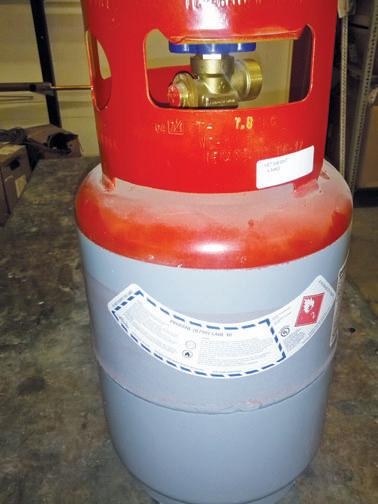
If the charge limits for hydrocarbon refrigerants increase, larger reach-in and display cases will be available that use propane.
knowledge in the technician and contractor base about the alternatives. This means that we sometimes choose refrigerants today that we know are not going to be the best choice next year.
It is not surprising that we are seeing more and more marketing material geared toward the use of natural refrigerants for commercial and residential applications. Hydrocarbons, CO2, and ammonia are seeing a resurgence and there is serious merit in considering them for many applications.
There is also a movement afoot to increase the current charge limits for hydrocarbon refrigerants; if this limit increases, larger reach-ins and display cases will be available that use propane or isobutane.
There is no easy one size fits all choice (yet?) and the consumer’s frustration with the synthetic refrigerant merry-go-round is understandable. I still remember getting yelled at by a grocery store owner when I told him I had to replace his R-401A (MP39) that he’d just put in a couple years before to replace the R-12 because the R-401A was now being phased out. At the time, HCFCs like R-401A were marketed as interim replacements. It’s starting to feel like all refrigerants are just interim replacements. ✚
Greg Scrivener is the lead refrigeration engineer and a partner at Laporte Consultants, Calgary, and works throughout Canada and the U.S. He is a professional engineer and journeyperson refrigeration mechanic. He can be reached at GScrivener@laporteconsultants.com.
Industry sti ll hoping for common sense
Continued from page 7
like for like where upgrading to condensing technology wasn’t possible.
“I think the other consideration, for those drafting the legislation, is that some building owners will just throw in the towel in and go with electric (heat pumps),” said Gervais. “Depending on the province you’re in and the electricity prices, I don’t think that’s going to be viable all the time, but I can certainly envision thatby 2025, it may be more popular.”
In a webinar meeting between manufacturers and NRCan this spring, there was a suggestion that a task force be created to examine extenuating circumstances, when “the venting is just not a possibility.” That offers some hope, said Goshulak, but he
High efficiency all the way in this Viessmann installation. Manufacturers are ready to help with difficult projects.
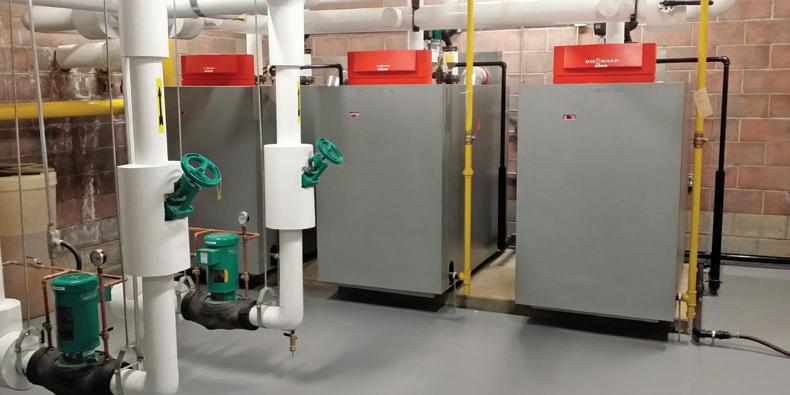
doesn’t believe that NRCan understands how many retrofit installations will be impacted.
“They are not saying they are going to agree to it, they are just saying we have to come up with a plan that deals with this. It could be 30 percent of the commercial jobs; it could be 60 percent. It’s not going to be two percent. It’s going to be a major issue on the commercial projects.” ✚
Staging mixed boiler systems
If a condensing boiler must be added to a multi-boiler system made up of non-condensing boilers, manufacturers can and will help. Mark Norris, Viessmann Academy instructor, Waterloo, Ont., suggests the following:
“When installing new condensing boilers into a system where non-condensing boilers need to remain, there needs to be some consideration for piping and staging to optimize the condensing boiler operation.
“Ideally the new condensing boiler(s) should be in parallel to

the system and the non-condensing boiler(s) in series with the condensing boiler(s). (See Fig. 1 and Fig. 2. These are just for discussion; not all components are shown.)
“The staging should then look at the condensing boilers as the lead to the non-condensing boilers. If you have more than one condensing boiler, then they can lead/lag rotate but any non-condensing boiler should always be the last boiler.
“The series parallel piping means that the non-condensing boiler doesn’t see the cool system return water directly but gets pre-warmed water from the condensing boiler. This reduces the thermal stress on the non-condensing boiler as well as the amount of energy that boiler needs to use to protect itself from colder water on the return.”
Fig. 1: Staging condensing and non-condensing boilers using a low loss header.
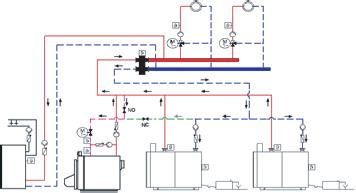
Fig. 2: This is another variation on a mixed condensing/ non-condensing boiler system.
Editor to retire after 22-years of service
By Mark Vreugdenhil
In 1998, Simon decided to leave a newspaper career for the plumbing and heating magazine in Toronto called Mechanical Buyer & Specifier. That magazine changed its name a few years later to Plumbing & HVAC.
Simon’s original plan was a short stay with the magazine until he found another newspaper position. Twenty-two years later, Simon has become a leading voice in the industry as a respected journalist helping his readers build their businesses.
When asked what Simon likes most about this industry, he said, “This is a creative industry. Our readers build things.” Over the years, Simon has interviewed countless contractors and engineers and attended many conferences and tradeshows. Some of his most cherished memories are transporting HVAC equipment in a Sikorski helicopter to a Toronto mall, horseback riding in Kananaskis, Alta., a nd attending a conference in beautiful Maui.
However, it all comes back to the people. One thing you will notice about every Plumbing & HVAC magazine is that he insists that we have people on our cover. “Product pictures are great, but our industry is about people building things.” This respect and admiration for the people in our industry has allowed Simon to connect with his readers and deliver content that matters.
Simon was presented with the President’s Award at the Heating, Refrigeration and Air Conditioning Institute of Canada’s 2019 conference and was recently recognized for his outstanding contributions to our industry by the Canadian Institute of Plumbing and Heating.
Simon, you were not only integral to Plumbing & HVAC’s success; you have impacted the whole industry with your straight-forward and honest approach to your craft. We all thank you.
Any chance he can get, Simon tests out a motorcycle. Here he is sitting on the Viega bike at a new Viega training center in Bloomfield, Colorado.


Skiing in Mont Tremblant with DeWalt was a highlight for Simon during his 22- year career with the magazine.



At the 2019 MCAC Nashville conference, Simon got into the festivities and wore a white cowboy hat for the evening event.
The HMCS Sackville – a World War II corvette – was definitely a highlight of the 2015 annual conference for the Canadian Oil Heat Association (COHA) in Halifax. At conferences, editors still like to have a bit of fun while making sure they meet deadlines. On a side visit to Orlando Harley Davidson, Simon tests out the Easyrider bike.











